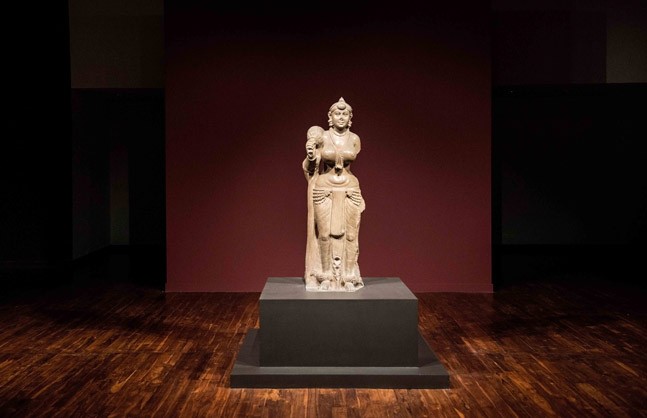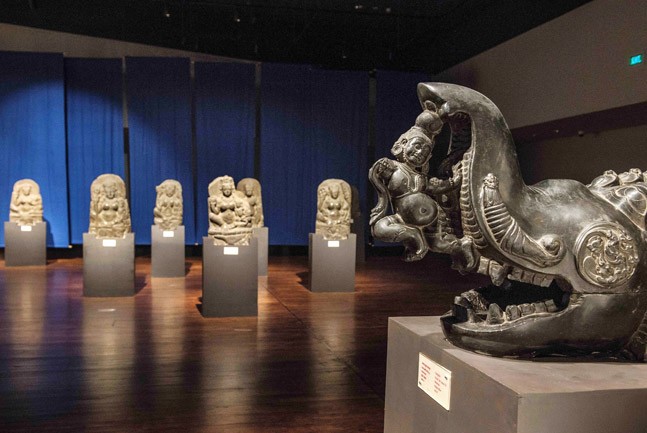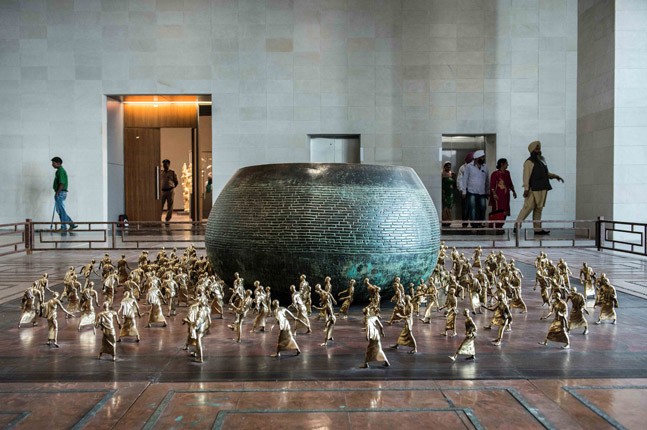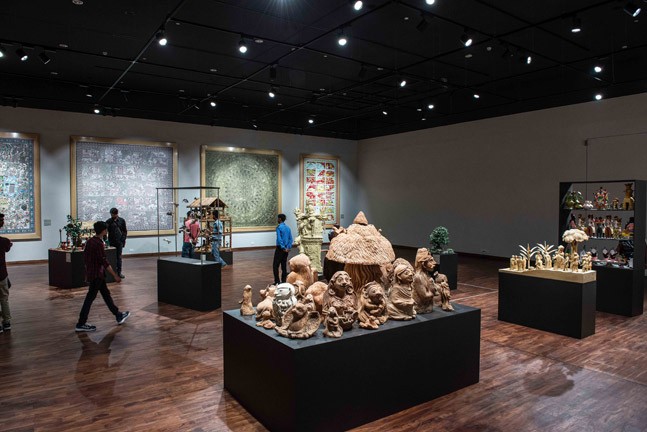Bihar Museum
This is a collection of articles archived for the excellence of their content. |
Bihar Museum
In their pitch, a little booklet called "I Am The Bihar Museum", a prose-poem invites the viewers to find a "special place and time within my many spaces, artifacts, stories and collections."
It says "the people of Bihar forget where they came from. I am here to remind them, to remind you, constantly preserving, constantly kindling the flame."
Art requires a story, he says.
And then, he refers to the Mona Lisa by Leonardo Da Vinci at the Louvre museum in Paris, where it is seen by six million people every year.
"Imagine that," he exclaims.
Annotated as life-size portrait, DaVinci's painting at the Louvre in Paris dating back to 500 years ago is perhaps a masterpiece but the highly polished Yakshi, a 5 feet 2 inches statue at the newly built Bihar Museum, could hold more intrigue in her timeless mystery.
The Chauri bearer stands against the dark red backdrop, illuminated by lights that accentuate hero unworldly curves. The silent guardian, the Yakshini, an earth spirit, is the beloved of many and is believed to be 2,300 years old.
"The Didarganj Yakshini is the Mona Lisa of Bihar. Even better," says Anjani Kumar Singh, the chief secretary of Bihar, as he talks about the leap of faith for the state with the new Bihar Museum, which is built at a cost of Rs. 500 crore and is possibly the biggest museum in terms of scale in the country and the wide ranging collection from historical to contemporary art.
"We must sell our stories. We must promote our heritage and our culture," says Anjani Singh, an IAS officer believed to be behind the massive museum project in Bihar that opened its doors to public on October 2, 2017. The sandstone sculpture dating back to about 2,500 years ago and discovered 100 years ago at the banks of the Ganges, stands in isolation of her stature as the one who meets the standards of beauty as described in the Pali and Sanskrit treatises. It is believed that the most prized collection of the Bihar museum is this statue, which belonged to the times of Emperor Ashok. As per the museum records, the sculpture was found by Ghulam Rasool in 1917 in Didarganj where villagers used the underside of her submerged back in riverside mud to wash clothes as recorded by the then commissioner of Patna EHS Walsh records.
"Imagine the vision of the artist to have carved her out of a single piece of sandstone," says JPN Singh, the Bihar Museum director.
When the international museum as it is commonly called for its "strange" architecture designed by a Japanese firm was inaugurated on October 2, and doors were opened to the public five years after it was conceptualized, India's 25 top living artists, including Himmat Shah, Subodh Gupta, Jatin Das and Arpana Caur, had walked in its corridors looking at their own works displayed in galleries alongside those that housed the ancient artifacts from so many centuries ago. With Rs 100 as ticket price, the crowds are swelling even on weekends. The museum is still work in progress and in the pipeline is a restaurant with curated Bihari dishes among other things. The Bodhi tree logo carved in wood at the entrance is the favorite selfie spot for the visitors.
"Imagine a village woman coming and looking at contemporary art," says acclaimed artist Subodh Gupta, whose installation will soon be part of the new museum. "Other states and the government of India must learn from Bihar."
In 2010, Chief Minister Nitish Kumar had been at the erstwhile Patna Museum when he was told what he witnessed wasn't even 20 percent of the collection of the museum. Because of limited space constraints, only about a fifth of almost 49,000 artifacts including thousands of palaeoliths, microliths and neoliths from different parts of Bihar, could be displayed. In India, around 1814, the first museum was built by the British in Kolkata and then in 1906, the second in Chennai. The Patna Museum or Jaadughar as it is commonly known was built as the third museum and opened to public in 1928.
After the visit, the CM decided to build a state-of-the-art museum and got together an international jury to select a design.
"The Bihar Museum is an investment in the future of Bihar," says Chief Minister Nitish Kumar. In July 2013, the foundation stone for the museum was laid.
In 2011, Maki and Associates was announced as the winner of an international competition for designing the Bihar Museum at Bailey Road and while the first phase was inaugurated in 2015, the doors were opened to the public to all its galleries on October 2, 2017. The government even called the top artists to participate in a camp for four days to make art on Gandhi to commemorate the Champaran movement and Gandhi Jayanti. Among them, Debanjan Roy, a Kolkata-based artist, painted a canvas with a "sad Gandhi" and used miniature style on a blue background to evoke the dark times we live in.
"This is a canvas that asks if non-violence was brace or not for Gandhi through his sad portrait," Roy says.
From 2010 onwards, Singh went as the nodal officer to observe all the museums of the world and says he felt that museums must have a connect to the society. For instance, he says, that Louvre and St. Petersburg museums are housed in "given buildings" and the museum on Bihar was envisioned also as a museum of architecture.
"We did not want to copy anyone," he says. "The Japanese design was simple and functional and it was ground floor plus one. The Japanese have a flair for keeping things simple. Cor-ten steel was used for the walls and a lot of people think the iron is rusted but it is an act by design."
There was no advisory committee and he had searched on internet for famous contemporary artists then and written to them. Anjani Kumar himself is an art collector for the last eight years and is almost a connoisseur.
"We had to draw a line because it was public money and I'd rather buy children ice cream than buy expensive artwork with public money because the display is going to help artists with a wide audience," he says.
Maki & Associates (Tokyo) with OPOLIS in Mumbai were in a close race with Foster & Partners who were awarded 75.59 percent against Maki's 77.56 per cent. The Cabinet of the Government of Patna approved the selection of Maki & Associates on 24th Jan, 2012. The Japanese design firm finalized a "campus" approach, which was complex and yet functional and organized, and includes an entrance pavilion, exhibition galleries, and administrative building, etc. The education area is located in a separate building located in the garden and gallery spaces are organized around a courtyard with the dispersed approach adopted to allow for flexibility in design.
Canada-based Lord Cultural Resources, the world's oldest cultural planning consultancy with more than 1800 museum and cultural planning assignments under its belt, were also roped in as the master planning consultants for this project.
Among the five chosen design firms out of list of 26 were Coop Himmelb(l)au (Vienna) with ARCHOHM, Foster plus Partners (London) with C. P. Kukreja & Associates, Maki & Associates (Tokyo) with OPOLIS, Snohetta (Oslo) with Spacematters, and Studio Daniel Libeskind (New York) with Morphogenesis chosen by an international jury comprising of Anjani Kumar Singh, who was then the Principal Secretary, Department of Human Resource Development and Nodal Officer for the project, artist Subodh Gupta, Dr. Martin Roth, Director, Victoria & Albert Museum, UK, Roisin Heneghan, Heneghan Peng Architects, Ireland, and Prof. Neelkanth Chhaya, Dean, School of Architecture, CEPT, Ahmedabad.
The design by Foster was beautiful, Anjani Kumar says.
"It had this roof like an egg holder you see in the market to play on the light and shadow but we wanted a simple structure that would show the tenacity of Biharis," he says.
And with this museum, we are looking into the future, he says.
"History must be experienced," he adds.
Built on a "campus" of 5.3 hectares, the museum provides 24,000 square meters of built area and uses unusual material like weathering steel for exterior cladding, which again is symbolic of metallurgy and India's prominence in international steel industry. With five sections, including multiple history galleries, a contemporary art and temporary exhibition gallery, a regional art gallery that is a tribute to the culture of Mithila, Bhojpur, Magahi and Angika areas, a diaspora gallery that focuses on the migrations history of indentured labourers and their subsequent relocation, and a children's gallery, it is perhaps one of the most ambitious projects undertaken by a state.
The collection ranges from Bodhisattvas statues, sculptures of Gandhar style to the artifact chest of Lord Buddha, which contains the ashes of Buddha, discovered in Vaishali. Now, the next museum in the pipeline is coming up in Vaishali to be carved out of stones for which 73 acres of land has been acquired and a Delhi-based architect firm is designing the museum which will house the ashes of Buddha. It is estimated the the museum will cost the state exchequer more than Rs. 300 crores.
According to the additional Museum director JPN Singh, the ashes were discovered in Vaishali in 1959 and it was brought to the Patna Museum.
"Every year, 2-3 lakhs tourists come to Bodh Gaya from all over. A museum in Vaishali with Buddha's ashes will be yet another tourist attraction," Singh says. "It will have a meditation center and artifacts related to Buddhism."
He says there are 25 museums in Bihar, which makes it a state with the most museums and these are rich museums.
"This museum is an experience museum and is in the complex structure category," he says. "The existing trees were not cut and the building was designed to accommodate them."
The chief secretary says Bihar doesn't need to be bothered by the stereotypical projections on to itself of an ailing state, deprived of cultural and historical contexts.
A poor state can dream big, he says.
At least three PILs have been filed in the Patna High Court asking the government to justify the logic of the expenditure behind the museum. In 2015, the Patna High Court directed the state government to submit an affidavit in this regard during the hearing of a public interest litigation (PIL) filed by a man named Ashok Kumar, which questioned the utility of constructing the museum utilising public funds. Five colonial style bungalows had to be demolished, including the one which was state accommodation for the income tax commissioner, to build the museum that stands out amidst the worn down buildings and the new glass and cement structures that define the landscape of Patna.
In many ways, given the volatility of politics and the claims for granting Bihar the status of a special state, the museum is an unjustified expense for many. But then, it is important to claim the past legacy, says Anjani Kumar.
"After independence, no museum has been made like this. The glass has come from Scotland and Germany, the fabricator from Singapore. While it is a historical museum, the other sections are very important. We believe that after Jharkhand was carved out of the state of Bihar, we could develop Bihar as an art and culture hub as we owned world class artifacts. The imagination is that we can hold a biennale," he says, referring to the mammoth convention hall, which is again worth about Rs. 500 crores and has a capacity of at least 10,000 people. This is our way of making Bihar an art destination," he says.
The museum has been registered as a society because such institutions cannot flourish under bureaucracy, according to Singh.
In November 2015, Anjani Kumar, whose sprawling government quarters at Circular Road, is a museum in itself with works from Himmat Shah to Kalal Laxma Goud's charcoal landscapes, wrote to 25 top living contemporary artists including the Satish Gujral and Subodh Gupta, the native of Bihar and considered the god of contemporary art. In fact, in 2012, the first public art display of his work was in Bihar during centennial celebrations, which was a 26-foot cactus made of thousands of stainless steel utensils at the Rajdhani Vatika eco-park in the capital. The artist had said the work was symbolic of the endurance of the people of Bihar. Singh invited the artists to donate their artworks against an honorarium payment of Rs. 5 Lakhani each for the contemporary section of the museum conceived in 2010. The contemporary art gallery has works ranging from Jatin Das to Arpita Caur and Himmat Shah. Outside the galley, an installation in bronze by the other famous export from the state Sanjay Kumar, who like Subodh Gupta graduated from the Arts and Crafts College in Patna in the, is yet another commitment to the state by its artists.
"I said I wanted the artworks because we would display it to public. I told the artists that here they could be viewed by the world rather than being just confined to galleries and homes of art collectors," Singh says.
In an open area, a plaque with an impression of the huge installation inspired by the idea of the Rangoli by Subodh Gupta stands. So far, the biggest installation by the artist who grew up in Khagaul and has often been hailed as India's Damien Hirst by the stalwarts in art who probably don't understand the nostalgia quotient of his work , Gupta is currently working on it and says the government will only cover the cost of the installation.
"For my state, I decided to do it," he says.
The herd of fish made by Jamui-based local craftsperson Pranmohan Sah, an auspicious symbol in Bihar, is hung with wires and seems like they are floating in space. At the regional art gallery, perhaps one of the more interesting spaces in the new museum, there are about 17 works to celebrate he culture and crafts of Bihar.
In a corner, Dulari Devi, 51, stands with the sari pallu drawn over her face. Hailing from Ranti, a small hamlet in Madhubani, she was Dulari Devi was awarded the Bihar State Award for Excellence in Art (2012-13) and a painting commissioned by the museum now hangs along with others celebrating the varied craft of her region.
"This canvas took me a year to finish and I have painted the scenes of our traditional Kamala Puja," she says.
Born in a community of fisher folk, she used to work as a house help at the residence of the famous Mithila painter Mahasundari Devi and watching her paint made her happy. She started assisting with filling colours and in time, she developed her own style. "They sold their paintings and I wondered if one day I could sell my paintings and earn money," she says.
She had been about 12 yeas old at the time and she enrolled in Sewa Mithila project to learn the craft.
The folklore and he tradition is forever preserved in her massive painting.
"We have a river called Kamala and we worship Lord Koylavir who once prayed for the wellbeing of fisherfolk to the river goddess and asked her not to flood us," she says. "It is a full moon night when we worship the river and the gods and use chillum, khaini, alcohol, etc for the puja."
All these are depicted in her painting in the Bharni style which according to Gupta is a masterpiece in itself.
"We have to push our crafts to the national and international level," says Anjani Singh.
In the room, there is an Aadi Shakti version made in papier mache by Sharad Kumar, who learned from stories told to him by his grandmother about the significance of the primeval deiti. And then, a terra-cotta installation inspired by the folklore of Sama-Chakeba, the daughter and son of Lord Krishna where the daughter was turned into a bird and later brought back to self by her brother, is in contrast with another terra-cotta installation, which is a parallel version of the same mythology but here Sama and Chakeba are lovers.
Ghosh, a senior of Gupta, who won the national award for his sculptures and terra-cotta work in 1984, is one of the most mysterious artists from Bihar. He has remained in Patna most of his life and is among the lost artists who never found patronage or support for their craft. In 2012, along with Gupta, Ghosh had made a nine-tonne iron and steel sculpture of Raja Shailesh, the king of Dusadh community in Mithila, at the same park for the Bihar Divas celebrations. A 1978 alumni of Patna College of Arts and Crafts, Ghosh says the museum is a beacon of light for artists in Bihar.
"It is a leap of faith for us," he says.
In the diaspora gallery, musical instruments, it seems, are floating in the air. This part is an ode to the indentured labourers from Bihar, who settled in countries like Mauritious, Guyana, the Caribbean Islands, etc. In November, when the chief minister and the chief secretary visit Mauritious, they would bring back artifacts to put in the diaspora museum.
"We must do all we can," he says.
At his residence, the stone sculptures by Himmat Shah are illuminated by the numerous lamps. The canvases are innumerable.
When he retires, he plans to open a private museum.
"Two rooms will be dedicated to the museum," he says. "As Biharis, we have to prove ourselves all the time. Now, we take over."
And this, despite everything.
Bihar Museum Biennale
2023
Sneha Bhura, August 21, 2023: The Times of India
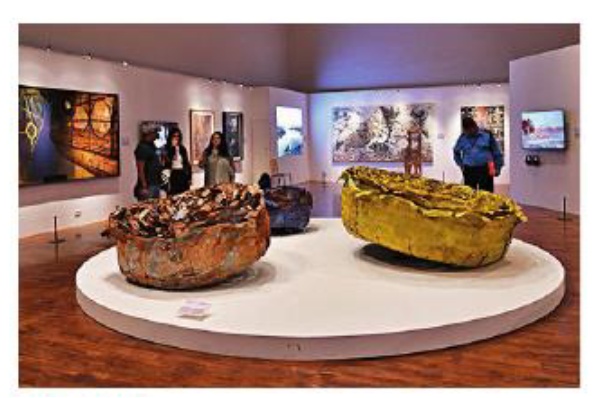
From: Sneha Bhura, August 21, 2023: The Times of India
The story of the Didarganj Yakshi, a much-admired showstopper at the Bihar Museum, is fascinating. The sculpture carved out of polished chunar sandstone holding a flywhisk with beautifully detailed jewellery and drapery was discovered in 1917 on the banks of the Ganga in the Didarganj city of Bihar. One story goes that the villagers used its stone slab which stuck out of the muddy waters as a washing board. Another says they went searching for a snake but unearthed the sculpture instead.
Leading a walkthrough at the second edition of the ongoing Bihar Museum Biennale in Patna, director-general Anjani Kumar Singh calls this beguiling mystery-in-stone the most important exhibit of the museum. A similarly decked out human counterpart and even bearing her signature flywhisk recounts the story of the Yakshi to onlookers who jostle to take pictures. Elsewhere, in the children’s gallery downstairs, a mother helps her seven-year-old child ‘match the jewellery’ against a digital image of the Yaskhi in an interactive game.
Estimated to be built at a cost of Rs 530 crore, the Bihar Museum was envisioned as a “world-class” space and seems to have lived up to that dream. At the opening of the Biennale, chief minister Nitish Kumar announced a 1. 5km-long “heritage tunnel” to connect the older Patna Museum to Bihar Museum in three years. Even as Prof Yannick Lintz, president of Musee Guimet in Paris, discussed how museums can become vibrant repositories of “universal culture” rather than static spaces of antiquities at a symposium, people in Patna got a chance to see contemporary art from G20 countries apart from nine guest countries like Bangladesh and Egypt in a special multidisciplinary exhibition called ‘Together We Art’ curated by Alka Pande. Other exhibitions include a display of the meticulous techniques behind the making of traditional Tanjore paintings, apart from collaborations with Salar Jung Museum in Hyderabad and a gallery of over 70 artworks encompassing Nepal’s syncretic spiritual landscape.
The Bihar Museum Biennale runs till December. “The next four and a half months will include all kinds of activities from quizzing and seminars to exhibitions and educational outreach initiatives. This will ensure the participation of people across age groups, professions and backgrounds,” says Singh. He also adds that there are two new museums coming up in Patna, a tech-focused homage to the life of Mahatma Gandhi called ‘Bapu Tower’ near Gait Public Library in Gardanibagh area and a modern science museum with a special focus on agriculture. “The biggest achievement of the Bihar Museum Biennale has been the many partnerships and collaborations we have forged. Our strong friendships with practitioners across folk and contemporary art, design, architecture, conservation and museum planning will see a bigger impact in the coming days,” says Singh, adding though there are several art biennales in the world, this museum biennale is the first of its kind.
Vishesh Chitransh, doing his bachelors in computer science at BITS Pilani in Goa, loves hanging out in the museum when he comes back for holidays. “Their music gallery is a treasure trove. Some of the rarest folk songs and recordings of old bands from Patna have been digitised for people to listen with just a tap of a button. Old, unknown instruments hang from the ceiling. Their histories and back stories are explained. I get completely lost here,” says Chitransh.
